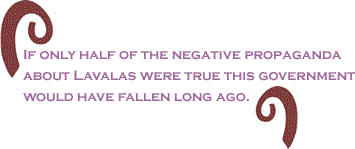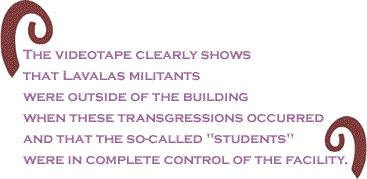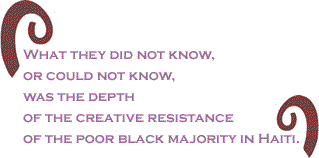
|
|||||||||||||||||||||
|
PORT-AU-PRINCE,
Haiti – Money
is power and power is money. The Bush administration buys and
sells political constituencies every day in pursuit of world
domination. Haiti, which recently celebrated its bicentennial
as the world's first black republic, is not otherworldly or immune
from purchase. Softening the ground for the transaction is the
corporate media that blatantly acquiesce to the U.S. State Department's
campaign to denigrate the rights and humanity of Haiti’s poor
black majority. There is no other way to describe their current
campaign to portray the opposition in Haiti as the new "freedom
fighters" of the hemisphere, out to topple the repressive “dictatorship” of
President Jean-Bertrand Aristide. The Washington-forged
opposition grows lighter in color and more brazen with each passing
day, while former Haitian Disinformation media
The Haitian press, most notably Radio Metropole, Radio Vision 2000, Radio Kiskeya, Radio Caraibe and Tele-Haiti, have shown themselves to be wanton whores in the campaign to sow confusion and panic among the people. They are active players in the U.S. campaign to destabilize Haiti's constitutional government. With total disregard for principles of "objective journalism," they circulate exaggerated reports of violence by Lavalas, turn a blind eye to violence on the part of the opposition, and underreport the size and frequency of Lavalas demonstrations demanding President Aristide fulfill his five-year term in office. They regularly produce and air commercials calling upon the population to "claim their democratic rights" by joining anti-Aristide street actions. Just as in Venezuela, where local elites use their media to spearhead the opposition to President Hugo Chavez, the clear objective in Haiti is to throw the constitution in the trash and force President Aristide to resign. Never mind that Radio Vision 2000 is owned by the same right-wing Boulos family that funds the Haiti Democracy Project in Washington D.C. Never mind that Tele-Haiti was founded by Andre Apaid, the self-proclaimed leader of Group 184 that was "created from whole cloth" by the Haiti Democracy Project. (See “The Bush Administration’s End Game for Haiti,” December 4.) Never mind that two prominent journalists of Radio Metropole were funded by the U.S. State Department to tour the United States in mid-January of this year to meet with editorial boards around the country to spread their message of the evils of Aristide's "dictatorship." Ignore the fact that they are a major source of information for the Associated Press, Reuters and France's venerable RFI whose reporters can be seen openly sharing "information" with them buddy-buddy style on any given day. Here’s the way it works: Metropole reports a fabrication; AP and RFI pick it up for their wire services, then Kiskeya and the others report it again in Haiti backed by the credibility of the international press. The positive feedback loop of disinformation for the opposition is now complete. Partners in crime
On December 3rd the rumor hit the streets of Port-au-Prince that President Aristide would be forced to resign on December 5th. Not so coincidentally, the justification for the latest round of protests against the Haitian government can be traced to December 5th and what Apaid and his minions refer to as "Black Friday." This date was previously etched in the Haitian popular memory as a day of memorial for the victims of a bomb that exploded during Aristide's first campaign for the presidency in 1990 in Petion-Ville. Instead, it has now been displaced with an alleged attack against university students by Lavalas. ”Alleged” is indeed the case. A videotape has been discovered of events at the university that day which appears to refute the description given by Radio Metropole and Tele-Haiti. Both outlets reported that popular organizations aligned with Lavalas broke through a back wall of the university, destroyed computers at the site and then proceeded to break the legs of the university's Rector after he entered the facility. However, the videotape clearly shows that Lavalas militants were outside of the building when these transgressions occurred and that the so-called "students" were in complete control of the facility when the Rector entered. Although they claim that Lavalas militants had burned a hole through a back wall, the opposition "students" can be seen pummeling the police and the press with large rocks and small boulders as they attempt to approach the building. As the Rector proceeds to enter with a police escort, the "students" can be heard chanting "no police" several times from behind the large metal gate, at which time the Rector is heard asking the police to let him enter unescorted. This does not sound like a compound under siege from within, but rather a site under the complete control of those inside. As you hear the crashing sounds of computers in the facility being broken, Lavalas popular organizations members comment on the tape, "Oh my god. They are going to blame us or the police after this is over." Photos have been taken of the "students" who controlled the facility from their rock throwing perch on the balcony, and some sources have said that arrests for questioning are imminent. The
tape irrefutably shows that the only camera crew allowed to
enter the facility
was Tele-Haiti, while the rock-throwing students kept the other
media outside. In that case, how could it be that Lavalas militants
were inside and in control of the university facility? One university
student who left the campus bloodied may hold the key. "We
were attacked by student members of the opposition for being
pro-Aristide,” he stated. “After they broke the computers they
realized they had gone too far and held a quick meeting. They
had cell phones and talked with someone on the outside. Then
they brought into the room the faculty member responsible for
the computers and he talked for several minutes with someone
on the cell phone. I could not tell who it was but he agreed
with them." Out of the shadows
Following the claims
of "Black Friday" came a torrent of protests against
the government from “students” supposedly violated by Lavalas.
But Andre Apaid's Group 184 clearly emerged as the true leadership
of the demonstrations. December 22 saw a large protest by Apaid’s
group calling for the resignation of President Jean-Bertrand
Aristide. These surrogates of Washington's war against
the poor in the Caribbean and Latin America, filled the streets
with nearly 10,000 people while a smaller contingent of Aristide's
Lavalas movement guarded the national palace. Michael Norton
of the Associated Press, as well as a heavy contingent of France's
press, witnessed this to conclude that it was merely a matter
of time before Aristide and his ugly little experiment in democracy
for the poor would fail. What they did not know, or could not
know, was the depth of the creative resistance of the poor black
majority in Haiti. It’s difficult to fault the foreign media’s
judgment, however, for money is power and power is money and
they can afford their next meal while the impoverished majority
in Haiti cannot. In a country as poor as Haiti, this is the difference
between knowing what is real and what is false. What non-Haitians
must try to understand is that if only half of the negative propaganda
about Lavalas were true, particularly that President Aristide
no longer enjoys wide support in the country, this government
would have fallen long ago. Kevin
Pina is a documentary filmmaker and freelance journalist
who has been working and living in Haiti for the past three
years. He has
been covering events in Haiti for the past decade and produced
a documentary film entitled "Haiti: Harvest
of Hope". Mr. Pina is also the Haiti Special Correspondent
for the Flashpoints radio program on the Pacifica Network's
flagship station KPFA in Berkeley CA. |
January
15,
2004 |
|||||||||
|
|||||||||
|
|
|||||||||
| Printer Friendly Version | |||||||||
| |
|||||||||
| |
|||||||||























 military leaders prance hand in hand
with Haiti's traditional economic elite, intellectuals and artists.
The poor black majority, who cannot read or write and continue
to support the constitutional government of President Aristide,
has been deliberately made indescribably poorer in an effort
to force them to turn against their own interests.
military leaders prance hand in hand
with Haiti's traditional economic elite, intellectuals and artists.
The poor black majority, who cannot read or write and continue
to support the constitutional government of President Aristide,
has been deliberately made indescribably poorer in an effort
to force them to turn against their own interests.





